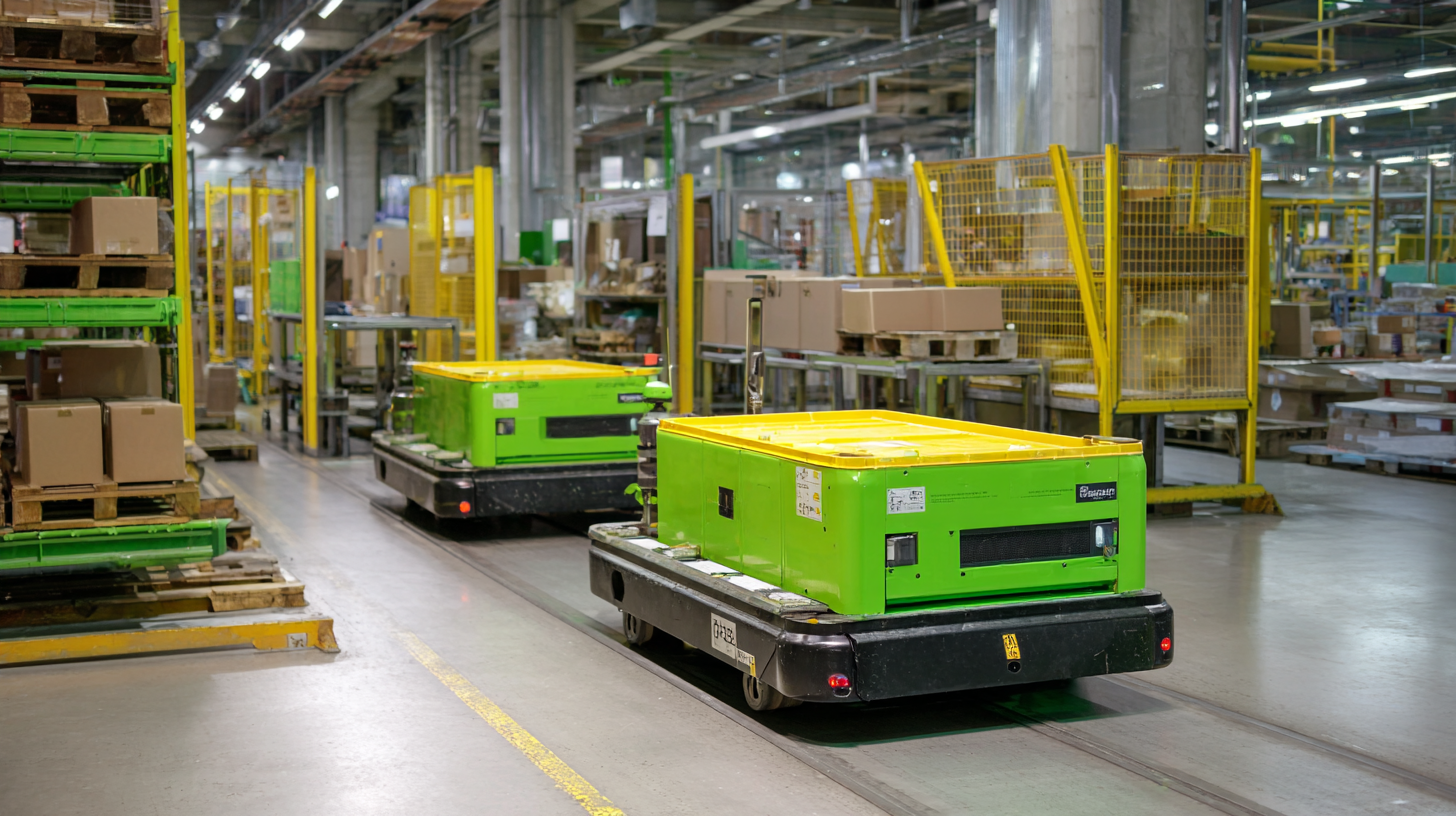Enhancing Warehouse Efficiency: The Impact of AGV Systems on Operational Costs and Throughput
In today's fast-paced logistics environment, enhancing warehouse efficiency has become a critical priority for businesses seeking to maintain a competitive edge. One of the most transformative technologies in this domain is the Automated Guided Vehicle (AGV) system, which has significantly impacted operational costs and throughput. By integrating AGV systems into warehouse operations, companies can streamline their processes, reduce human error, and optimize the flow of goods within their facilities.
The implementation of AGV systems not only minimizes labor costs but also improves overall productivity, allowing warehouses to handle greater volumes of inventory with reduced lead times. This shift towards automation is crucial as businesses face increasing demands for faster order fulfillment and inventory accuracy. As we delve into the implications of AGV systems on operational dynamics, it is essential to understand the quantitative benefits they bring to the table, including potential savings and enhancements in throughput rates. Exploring these factors will shed light on how AGV systems can redefine warehouse operations for the future.

Assessment of AGV Systems: Cost-Benefit Analysis for Warehouse Operations
The automated guided vehicle (AGV) market is rapidly evolving, driven by the increasing demand for efficiency in warehouse operations. As businesses strive to reduce operational costs and enhance throughput, a comprehensive cost-benefit analysis of AGV systems becomes essential. The market can be segmented by type, including towing vehicles, automated forklifts, collision/tunnel vehicles, assembly line vehicles, and other unit load carriers. Each type offers unique advantages, influencing the overall effectiveness of warehouse operations.
Moreover, AGVs are categorized by navigation technology, with laser, magnetic, and visual navigation systems each providing distinct operational benefits. Laser-guided vehicles, for instance, offer high precision in navigation, while magnetic AGVs may provide lower installation costs and simpler operational setups. As warehouses look to optimize their layout and workflow, understanding the implications of each AGV type and navigation technology on capital investment and operational efficiency is critical. This sophisticated evaluation aids warehouse managers in determining the most suitable AGV solutions tailored to their specific needs, ultimately contributing to enhanced productivity and reduced costs.
Enhancing Warehouse Efficiency: Impact of AGV Systems
This chart illustrates the operational costs and throughput before and after the implementation of AGV systems in warehouse operations. The data shows a significant reduction in costs and an increase in throughput, demonstrating the effectiveness of AGV technology in enhancing warehouse efficiency.
Key Factors Influencing Throughput Improvement with AGV Adoption
The adoption of Automated Guided Vehicles (AGVs) is transforming warehouse operations, significantly enhancing throughput while reducing operational costs. By integrating AGVs into their logistics framework, companies are not just streamlining processes but also increasing efficiency. The global AGV and Autonomous Mobile Robots (AMRs) market is projected to experience robust growth, with an expected market size reaching USD 40.5 billion by 2028, showing a CAGR of 14.6% during the forecast period. Factors influencing throughput improvement with AGV adoption include real-time data analytics, advanced routing algorithms, and seamless integration with existing warehouse management systems.
Tips: Consider using advanced AGV dispatch management platforms, which are anticipated to reach USD 14.0 billion by 2035, to enhance operational efficiency further. Implementing efficient load management practices can also minimize travel time for AGVs, leading to improved throughput. Moreover, keeping an eye on emerging technologies like 5G networks can offer enhanced communication capabilities for AGVs, resulting in faster response times and increased operational agility.
Enhancing Warehouse Efficiency: The Impact of AGV Systems on Operational Costs and Throughput
| Warehouse Type | AGV Type | Operational Cost Reduction (%) | Throughput Improvement (%) | Average Cycle Time (minutes) | AGV Utilization Rate (%) |
|---|---|---|---|---|---|
| Retail | Towing AGV | 25% | 30% | 10 | 85% |
| E-commerce | Unit Load AGV | 20% | 40% | 8 | 90% |
| Manufacturing | Forklift AGV | 30% | 35% | 12 | 80% |
| Pharmaceutical | Pallet AGV | 15% | 25% | 15 | 75% |
Integration Challenges: Implementing AGV Systems in Existing Warehouses
Implementing Automated Guided Vehicle (AGV) systems in existing warehouses presents significant integration challenges that organizations must tackle to enhance their operational efficiency. A report from the Warehousing Education and Research Council (WERC) indicates that over 40% of warehouses are struggling with technology integration, which often leads to extended deployment times and increased costs. The necessity to retrofit existing infrastructure to accommodate AGV systems can lead to unexpected expenses, requiring careful planning and execution.
When considering AGV implementation, it's crucial to conduct a thorough assessment of current warehouse layouts and workflows. By mapping out the existing processes, companies can identify the best routes for AGVs and reduce potential bottlenecks during the integration phase. According to a study by Material Handling Industry (MHI), companies that invest in comprehensive pre-implementation audits tend to improve throughput by up to 30%.
Tips: Ensure all stakeholders are involved in the planning process to address potential constraints early. Investing in user training for warehouse staff can smooth the transition and increase overall acceptance of the new system. Additionally, consider pilot testing AGV systems in less critical areas to gauge effectiveness and refine operational strategies before full-scale deployment.
Comparative Analysis: AGVs vs. Traditional Material Handling Methods
 As the demand for efficient warehouse operations continues to rise, businesses are increasingly turning to Automated Guided Vehicles (AGVs) as a way to streamline their material handling processes. A comparative analysis between AGVs and traditional methods reveals significant advantages for the former. According to a report from the Material Handling Industry of America (MHIA), warehouses that implement AGV systems can reduce operational costs by up to 30%. This reduction is primarily attributed to decreased labor costs and improved accuracy in inventory handling, which minimizes the risk of costly errors.
As the demand for efficient warehouse operations continues to rise, businesses are increasingly turning to Automated Guided Vehicles (AGVs) as a way to streamline their material handling processes. A comparative analysis between AGVs and traditional methods reveals significant advantages for the former. According to a report from the Material Handling Industry of America (MHIA), warehouses that implement AGV systems can reduce operational costs by up to 30%. This reduction is primarily attributed to decreased labor costs and improved accuracy in inventory handling, which minimizes the risk of costly errors.
Furthermore, AGVs significantly enhance throughput, allowing warehouses to process more orders in less time. Research from the Warehouse Education and Research Council (WERC) indicates that AGV systems can improve goods-to-person picking efficiency by 200% compared to conventional material handling methods. This increase in efficiency not only accelerates the order fulfillment process but also contributes to customer satisfaction, as quicker delivery times are achieved. The shift towards AGVs not only represents a technological advancement but also marks a strategic move for companies looking to gain a competitive edge in the fast-paced logistics landscape.
Future Trends: Advancements in AGV Technologies and Warehouse Efficiency
The market for Automated Guided Vehicles (AGVs) is experiencing significant growth, driven by advancements in technology that enhance warehouse efficiency and reduce operational costs. Segmented by type, the AGV market includes traction vehicles, automated forklifts, collision/tunnel vehicles, assembly line vehicles, and others, such as unit load carriers. Each type plays a pivotal role in streamlining warehouse operations, providing tailored solutions to meet specific logistical challenges.
As for navigation technology, the landscape is diverse, featuring laser navigation, magnetic navigation, vision-based systems, and more. Laser navigation offers precision and flexibility, while magnetic navigation ensures reliability in structured environments. Vision-based systems leverage AI and imaging technology for real-time decision-making in dynamic settings. Adopting the right navigation method can significantly impact throughput and efficiency, making it crucial for warehouses to assess their unique needs carefully.
Tips:
To maximize the benefits of AGV systems, consider conducting a thorough analysis of your warehouse layout and operational workflow. Investing in hybrid navigation platforms can provide the best of both worlds, combining reliability and adaptability. Lastly, regular maintenance of AGVs is essential to ensure optimal performance and longevity within your logistics framework.

Related Posts
-

Understanding the Future of Logistics with Advanced AGV Systems in Modern Warehousing
-
Understanding the Future of Logistics with AGV AMR Technology Innovations
-

Exploring the Future: Unconventional Robotics Careers You Never Knew Existed
-

Understanding the Importance of Robot Safety in Modern Automation
